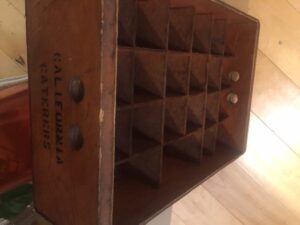 My partner John, a bicycling enthusiast, brings me things he finds in people’s free piles. There’s always the “free stash” these days, as folks grow tired of their spaces.
My partner John, a bicycling enthusiast, brings me things he finds in people’s free piles. There’s always the “free stash” these days, as folks grow tired of their spaces.
This week John presented me with an old bottle box, with old stenciling: “California Caterers.” He thought I might use it for small bottles. It looks like the old wooden containers they used to deliver soft drinks in. I did a search online for California Caterers. John found this in a home driveway close to the Mission so I suspected this company as local to Santa Barbara. I see Santa Barbara Catering Company has been in business for 37 years. I’ll assume the box is thirty plus years old, and originally from this company.
The Hansen family ran the company, if I’m right, and I’ve eaten their food at the Santa Barbara Kennel Club dinner. They served the esteemed judges, 130 of them, then catered the 1,200 other people at the event table there.
I also tasted their food at the Santa Barbara French Festival, for years a favorite of mine, as I knew the founder Steve. The company catered a French style tri-tip with MOUNDS of garlic (of course) and grilled onions on baguette with brie cheese.
Age of the Bottle Box?
John left it up to me to find out the age of the bottle flat. I know of two ways to determine the age of an wooden object. One is the DIRT, and the sun and heat damage, assuming they stored it in a hot Santa Barbara garage. I washed the bottle box to take good photos and indeed 30 plus years of grime came off.
The other way to tell the age of a wooden object is to measure the wood construction. The planks in the direction of the grain should remain about the same length. In other words, fitting inside the box in the way they did 30 plus years ago, and the wood that is NOT cut along the grain expands or contracts, if the wood has been exposed to moisture or hot dry conditions. THIS box shows the hallmarks of being about the same age as my son (35 years) according to the measurements I did using a caliper.
I spoke to Betsy J Green in regard to her new book Movies and Million Dollar Mansions. The book serves as a wonderfully illustrated history of the early silent movies set in the most fabulous early 20th century mansions in Montecito. WHY? It seems the folks in Montecito at the time (1900-1920) enjoyed the company and confusion of a film set. Film directors shot in the daylight, not like the immoral thespians of the late-night stage. Many of our greatest mansions opened to silent movie actors, directors, and designers as a diversion. These mansions, often second homes, existed in the not all that exciting Montecito of 1915.
Where Catering Comes In
The owners, with Montecito mansions for a second or third home, longed for a bit of “color” in their daylight hours. They welcomed the silent movie stars, and asked local grocery stores to cater for lunches. Thus, the catering industry in Santa Barbara developed way back then.
I noticed in Betsy J Green’s book that the mansion Bellosguardo in 1915 hosted the cast and crew of The House of a Thousand Scandals! What fun to get deep in the scandals, if you owned the mansion, over a catered lunch!
I cannot put a value on the bottle box flat John dragged home, but it speaks of an era when Santa Barbara became a destination for events circa 1980s. It also reminds us that our town became renowned for events such as silent films as far back as the 1915. Apparently, people all over the world saw our mansions in film, since silent films didn’t come with language barriers. Please check out Betsy J Green’s Movies and Million Dollar Mansions at any local bookstores.